AMD FX-8370E CPU Review: Vishera Down to 95W, Price Cuts for FX
by Ian Cutress on September 2, 2014 8:00 AM ESTGaming Benchmarks
F1 2013
First up is F1 2013 by Codemasters. I am a big Formula 1 fan in my spare time, and nothing makes me happier than carving up the field in a Caterham, waving to the Red Bulls as I drive by (because I play on easy and take shortcuts). F1 2013 uses the EGO Engine, and like other Codemasters games ends up being very playable on old hardware quite easily. In order to beef up the benchmark a bit, we devised the following scenario for the benchmark mode: one lap of Spa-Francorchamps in the heavy wet, the benchmark follows Jenson Button in the McLaren who starts on the grid in 22nd place, with the field made up of 11 Williams cars, 5 Marussia and 5 Caterham in that order. This puts emphasis on the CPU to handle the AI in the wet, and allows for a good amount of overtaking during the automated benchmark. We test at 1920x1080 on Ultra graphical settings.
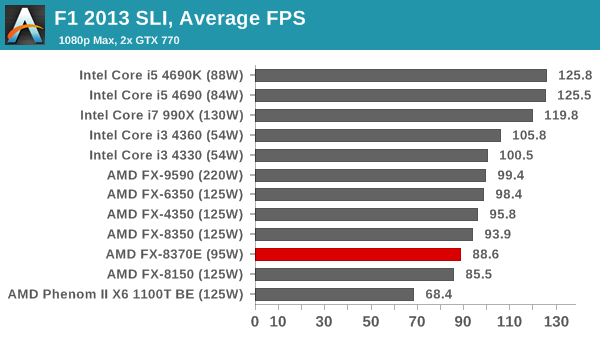
In all combinations, the 8370E and the 8150 duke it out. F1 2013 seems to be an Intel dominated title, given the i3 and outperform the FX-9590.
Bioshock Infinite
Bioshock Infinite was Zero Punctuation’s Game of the Year for 2013, uses the Unreal Engine 3, and is designed to scale with both cores and graphical prowess. We test the benchmark using the Adrenaline benchmark tool and the Xtreme (1920x1080, Maximum) performance setting, noting down the average frame rates and the minimum frame rates.
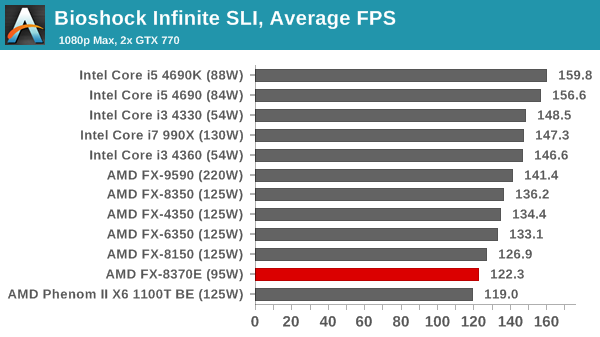
The FX-8350 again fits in just beneath the FX-8150, but for a lower power consumption.
Tomb Raider
The next benchmark in our test is Tomb Raider. Tomb Raider is an AMD optimized game, lauded for its use of TressFX creating dynamic hair to increase the immersion in game. Tomb Raider uses a modified version of the Crystal Engine, and enjoys raw horsepower. We test the benchmark using the Adrenaline benchmark tool and the Xtreme (1920x1080, Maximum) performance setting, noting down the average frame rates and the minimum frame rates.
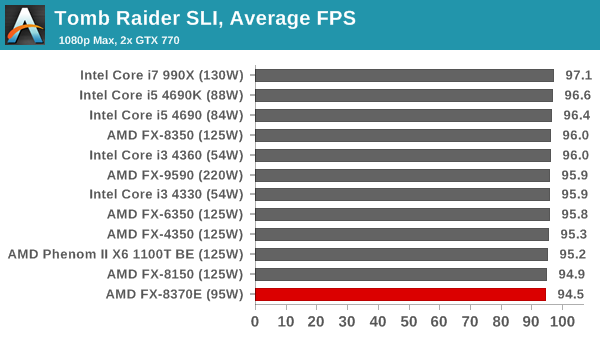
Tomb Raider continues to be CPU agnostic, even around the FX quad thread CPUs.
Sleeping Dogs
Sleeping Dogs is a benchmarking wet dream – a highly complex benchmark that can bring the toughest setup and high resolutions down into single figures. Having an extreme SSAO setting can do that, but at the right settings Sleeping Dogs is highly playable and enjoyable. We run the basic benchmark program laid out in the Adrenaline benchmark tool, and the Xtreme (1920x1080, Maximum) performance setting, noting down the average frame rates and the minimum frame rates.
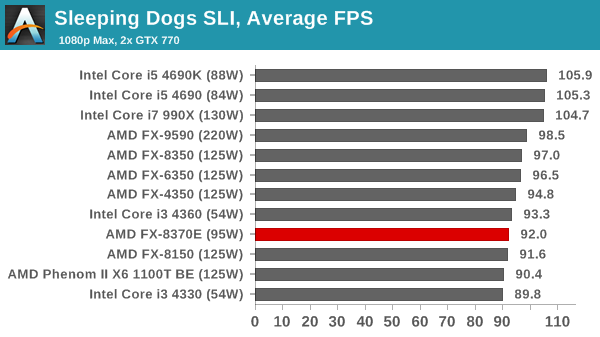
The eight threads offers some advantage in minimum frame rates, but average frame rates are still around the FX-8150.
Battlefield 4
The EA/DICE series that has taken countless hours of my life away is back for another iteration, using the Frostbite 3 engine. AMD is also piling its resources into BF4 with the new Mantle API for developers, designed to cut the time required for the CPU to dispatch commands to the graphical sub-system. For our test we use the in-game benchmarking tools and record the frame time for the first ~70 seconds of the Tashgar single player mission, which is an on-rails generation of and rendering of objects and textures. We test at 1920x1080 at Ultra settings.
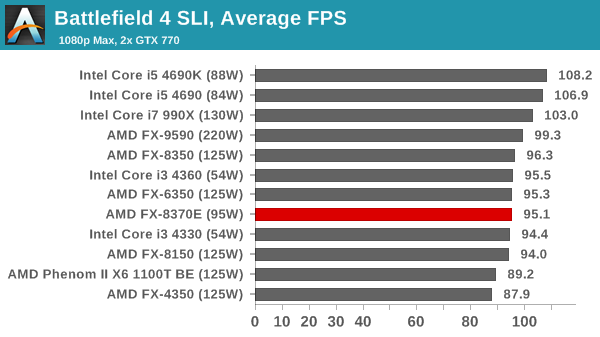
The FX-8370E stretches its legs a little in terms of minimum frame rates, particularly in SLI, however it is handily beaten by the i3-4330.















107 Comments
View All Comments
Kjella - Tuesday, September 2, 2014 - link
"Personally, I'd much rather see AMD make a comprehensive and honest effort to open up about their future products and roadmaps"AMD has been fairly clear on where they're going in their investor briefs, but it's probably not what you want to hear. They're executing a "transformation strategy" to get 50% of their revenue from the "Enterprise, Embedded and Semi-Custom segment" as opposed to the "Computing and Graphics segment" which is the traditional AMD/ATI business.
Where do you think this funding comes from? The CPU/APU/GPU research and development they're not doing, like a FX successor. And with that no new chipset, no new socket, no new motherboard validation. If you haven't noticed, they've been on a skeleton crew for some time now. All they're hyping is HSA which is semi-custom tech because normal apps have to serve the 80%+ not running AMD APUs.
For us, the mass market consumers of retail CPUs and GPUs I can give you a pretty accurate but grim forecast, AMD will continue to dodge direct competition. They can't compete with Intel on performance or power efficiency and with Intel so far ahead in processing technology they can't afford to undercut them on price either. Whatever their dual ARM/x86 processor ends up being, I'm pretty sure it's not primarily for us regular consumers.
haukionkannel - Tuesday, September 2, 2014 - link
Did you read the ansver from AMD about future FX prosessors. It seems that power efficiency is the way they are going next. Guite sensible because FX prosessor are fast enough all normal people, and they have no chance against Intel in the high end. They just not have enough money to compete properly.Maybe we see in the future a little bit faster Jaguar mini cores in FX line and normal Jaguar editions in mainstream APU machines. In that segment they have some possibilities to fight ARM and Intel processors.
Spoony - Tuesday, September 2, 2014 - link
I so much want to be able to shop between Intel and AMD when I purchase a CPU. Make it happen for me, AMD!zmeul - Tuesday, September 2, 2014 - link
when your FX CPU performs worse than an i3 CPU (in quite a lot of tests), it's time to change or get out of the businessKevin G - Tuesday, September 2, 2014 - link
This is a case of AMD kicking the can down the road. This release is meant to keep socket AM3+ limping along for a little while longer. Without a design refresh (Steamroller) and a new chipset, there hasn't been a reason to recommend the socket AM3+ platform for over year. Sure, it is nice that current owners have an upgrade path to faster parts. Considering the time it has taken to get these faster or more energy efficient parts to market one has to question if the wait has been worth it? Especially when compared to the evolving platforms on the Intel side.landerf - Tuesday, September 2, 2014 - link
Jesus those charts were brutaltexasti89 - Tuesday, September 2, 2014 - link
I don't see any substantial improvement in the per/watt ratio for these new SKUs. The performance data still look dismal against Intel's low end chips. As much as I want AMD to compete on the intended space for these chips, but these Bulldozer-based cups are truly pathetic. I'm really fed with these CPUs coming out in reviews for year by now.Germanicus - Tuesday, September 2, 2014 - link
So the comments, as predicted, are full of AMD-bashing. But lets think about his a second: do you really expect a company with 1/10th the resources of Intel to even come close to match it in performance and efficiency? Not only that, but AMD has multiple product types to juggle it's resources on (CPU/GPU/APU) whereas Intel has only a single focus.Not only that, but at least when buying AMD you don't get that dirty feeling you experience when you buy from a company like Intel, with it's lengthy history of anti-competitive business practices.
AMD is working on a new architecture, but it takes time. Patience, grasshopper!
mrdude - Tuesday, September 2, 2014 - link
Oh, are they? What TDP? What platform? Desktop/notebook/server? All 3? Socket? Target market segment? What about performance? Will it be better performing or equivalent but lower power? Neither? Does the x86 version outperform the ARM? Or is it vice versa? Is it going to be the same general architecture or are we talking two completely different architectures with different features? SoC or chipset? SoC + chipset? Is it BGA only or are we going to be able to buy socketed versions? Is AMD even going to release another chip for DIY'ers and enthusiasts post-Carrizo at all?All of the those are unanswered. Every single one. Think about that for a second and digest it. You're asking for patience when there isn't even a general direction or roadmap. So patient for what exactly?
The comments above aren't AMD bashing, but rather product bashing. AMD hasn't been competitive for a long while now and rehashing the same wasn't-competitive-even-then product doesn't help matters any.
So don't mistake peoples' frustrations with AMD as AMD-hating or AMD-bashing, but AMD-disappointment. There's a huge portion of the population that wants to buy an AMD CPU/APU but has been waiting since the Bulldozer debacle to find something even remotely interesting -- and I'm most certainly in that camp.
Germanicus - Tuesday, September 2, 2014 - link
They've already answered some of your questions, but I'm not going to Google for you.